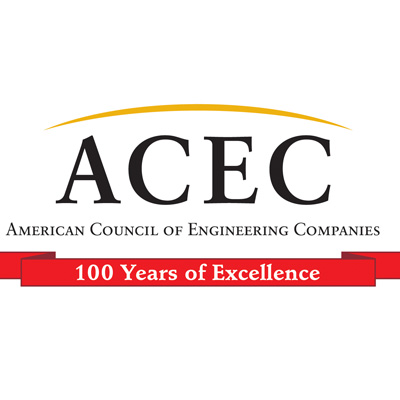AMERICAN COUNCIL OF ENGINEERING COMPANIES (ACEC)
Capitol Hill-Savvy Industry Leaders Weigh in on Potential Legislative Agenda
By Alan Joch
 Industry leaders were encouraged when President-elect Donald Trump—who proposed $1 trillion for infrastructure during his campaign—reaffirmed in his victory speech his aim to make America’s infrastructure “second to none” while putting millions of people to work and doubling the pace of economic growth.
Industry leaders were encouraged when President-elect Donald Trump—who proposed $1 trillion for infrastructure during his campaign—reaffirmed in his victory speech his aim to make America’s infrastructure “second to none” while putting millions of people to work and doubling the pace of economic growth.
ACEC President and CEO Dave Raymond sent a letter to Trump outlining critical infrastructure and regulatory issues. And Engineering Inc. polled executives engaged with ACEC’s advocacy program to get their take on legislative issues and prospects for progress in the 115th Congress.
Progress or More Polarization?
“We’re hopeful of seeing progress on transportation and infrastructure, energy and national security—those are areas where Congress and the new administration should be able to work together to produce results,” says Brian Tynan, director of government relations, AECOM. “These have been fairly bipartisan issues and ones not necessarily subject to the makeup of Congress and the administration. These are clearly all places that the incoming Trump Administration will look to advance its priorities with the Republican majority in Congress.”
Similarly, Jack Hand, chairman of POWER Engineers, hopes a new administration can create a more collaborative atmosphere in Washington. “The new president will make a greater effort to work with Congress,” he says. “President Obama over the last eight years really didn’t engage enough with Congress, and that hurt.”
But engineering executives are also realists. “While everyone agrees that infrastructure is of great importance to the economy as a whole, lawmakers must agree on how we can pay for the infrastructure investment that we really, really need,” says Elizabeth Burkhart, executive vice president, Collins Engineers, Inc.
Political fights will likely begin immediately, as politicians start campaigning for the next election on Inauguration Day.
Transportation Funding
Despite optimism about Trump’s commitment to use increased infrastructure spending as a path to more U.S. jobs and private sector growth, engineering leaders still say long-term and sustainable transportation funding remains a top industry challenge.
Trump has proposed spending $1 trillion on roads, bridges, airports, pipelines and the electrical grid, compared to the $305 billion, five-year FAST Act approved by Congress in late 2015. His plan calls for using $137 billion in tax credit incentives to help subsidize equity costs, which would in turn leverage additional funds and spur public-private partnerships totaling as much as $1 trillion over 10 years for transportation funding.
In his letter to Trump, Raymond urged the new administration to pursue a balanced approach in its infrastructure agenda, coupling initiatives to promote private investment and public-private partnerships (P3s) with new funding for core federal programs, including the Highway Trust Fund.
“The FAST Act provided short-term funding certainty for improving our transportation infrastructure, but we’re approaching another funding cliff for the Highway Trust Fund in 2020,” says Lisa Glatch, executive vice president, CH2M. “It would serve us well to establish a sustained investment program to address that gap sooner rather than later.”
Industry representatives would like to see more reliable funding mechanisms for large-scale projects, so their clients can accurately plan multiyear initiatives. Funding options that are top of mind for many engineers are P3s. “The FAST Act has provisions to encourage P3s, which would apply for state and local infrastructure,” Burkhart says. “The federal government also owns transportation infrastructure, such as locks and dams on the inland marine transportation system, that still need to be addressed.”
Tynan calls the need for a long-term transportation funding fix “pretty dire.” While the recently enacted FAST Act was fully funded over its five years, the Highway Trust Fund revenues will again run drastically short at the end of the act and a solution needs to be found soon. “But each of the potential funding mechanisms has political challenges associated with it,” Tynan says.
This sets the stage for the engineering industry to become politically active in the months ahead. “We need to keep pressing for a solution that’s long term and sustainable, so we don’t have to keep coming back and fighting the same fight over and over,” Tynan says.
Water and Taxes
Engineers also agree that funding for water projects should be a major focal point. “To avert a national water crisis, we need to increase federal funding and financing programs to support local communities” adds Glatch.
Others say comprehensive tax reform may have a ripple effect on several industry issues. “One of the pieces of legislation that is necessary for the country is comprehensive tax reform,” says Paul Yarossi, executive vice president, HNTB Corp. “Good things have happened for our industry in the years when there has been comprehensive tax reform. The last two significant increases in transportation funding, for example, came during the tax reform process.”
Energy Reform
A comprehensive energy bill also is vital. Creating a bridge from coal to gas is critical for energy security, says Hand. “Everybody wants a CO2- free environment, and we’ve been doing a nice job moving in that direction by replacing old coal plants with combined-cycle natural gas facilities that produce significantly fewer emissions,” Hand says. “We have to continue the transition from coal to natural gas, and during that process we’ll need to make energy storage more viable. All of this should absolutely be a part of a comprehensive energy bill we would like to see—unfortunately, it’s not included in the bill of the recent Congress.”
The need continues to exist for Congress to speed up the federal permitting process for large projects. “We have seen electric delivery lines, gas pipelines, natural-gas combined-cycle plants all being delayed by lack of momentum in environmental permitting. For example, our firm is working on a project to build a transmission line. We’re about eight years into the process of just getting the environmental permits,” Hand says. “In California, delays like that have been the norm for decades, but until recently that hasn’t been the case in the rest of the U.S. That’s holding up billions of dollars ready to be invested in infrastructure.”
Download the latest issue of Engineering, Inc.
 About the American Council of Engineering Companies
About the American Council of Engineering Companies
www.acec.org
The American Council of Engineering Companies (ACEC) is the voice of America’s engineering industry. Council members – numbering more than 5,000 firms representing more than 500,000 employees throughout the country – are engaged in a wide range of engineering works that propel the nation’s economy, and enhance and safeguard America’s quality of life. These works allow Americans to drink clean water, enjoy a healthy life, take advantage of new technologies, and travel safely and efficiently. The Council’s mission is to contribute to America’s prosperity and welfare by advancing the business interests of member firms.
Tags: ACEC, Alan Joch, American Council of Engineering Companies, Donald Trump, Engineering Inc., President-Elect Trump






 RSS Feed
RSS Feed